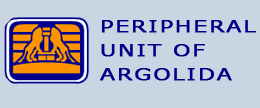The Acronauplia
| The rocky peninsular of the Acronauplia comprised the walled settlement of Nauplion from ancient times until the end of the 15th century.
The Acronauplia walls bear witness to its rich history, which it must be confessed, is a little difficult to follow, due to its long uninterrupted inhabitation. The current form of the castle, although quite changed by modern intervention, basically crystallised during the Frankish and first Venetian occupations from the 13th to 16th centuries. Evidence of a pre-historic settlement has been found, and on the west side, a section of the ancient polygonal walls from the 4th century BC has survived. There are also remains of the walls from the Hellenistic and Byzantine periods. |
||
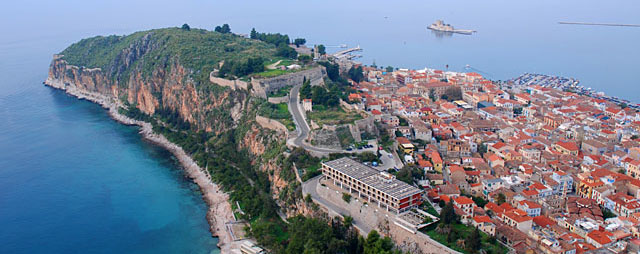 |
||
| From 1210-1212, when the Franks invaded the city, they divided the Acronauplia into two enclosures that they called castles. More or less in the middle of the peninsular was the Castello dei Franchi, which was built to house the Frankish leaders and became the administrative and military headquarters of the city; while the Castello dei Greci, in the western sector, further up, was built for the Greeks.
The Castello dei Greci must have existed during Byzantine times while the Castello dei Franchi must have been built a little later. The Franks built a wall between the two castles and a square tower in the middle of the hill, to control communication between them. In the eastern wall of the Frankish castle there was a gate protected by two circular towers and a triangular fort. This gate was decorated with interesting murals and became known as the 'Gate of Peace'. During the first Venetian occupation, and more specifically in 1470 during the command of Vettore Pasqualigo, the Venetians, threatened by Turkish raids, proceeded with repairs and extensions to the fortifications of the Acronauplia, under the supervision an important engineer of the time, Antonio Gambello. |
||
|
One of the first and most important projects was the addition of a new enclosure, the so-called Castello di Toro, below and to the east of the Castello dei Franchi. The name probably comes from the Italian word 'torrione', which means a large tower adjoining the walls of a fort. |
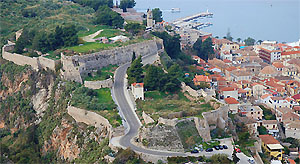 |
|
|
The Castello di Toro is still in good condition today and, after climbing the steps from the Catholic church, one can admire the imposing round tower with its crenellations, which protects the city gate; an excellent example of late renaissance style. |
||
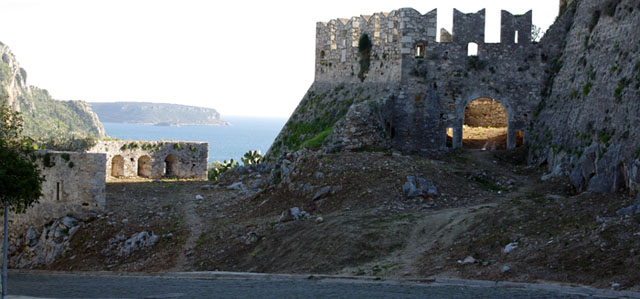 |
||
|
Another work from the time was the so-called Traversa Gambello, which was designed to protect the Castello dei Franchi by the building of a second transverse wall between it and the Castello dei Greci. The gate between the two castles was reinforced with a polygonal bastion and a semi-circular wall with crenellations. |
||
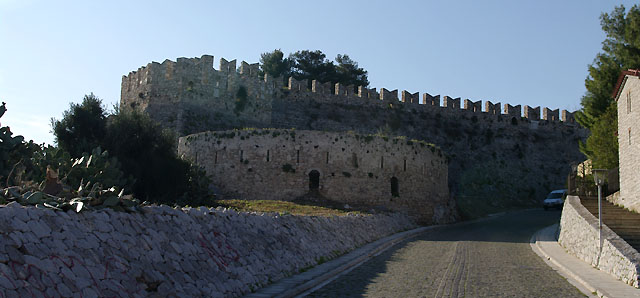 |
||
|
During the years of the first Turkish occupation, there were only a few re-enforcements and additions made to the castle, which was known by the Turks as Ich-cale, in other words the interior castle. It was inhabited by ordinary citizens, Turks and Christians, as the officers' residences had moved to the lower city. |
||
|
In 1686, when the Venetians seized the city from the Turks, they ordered that there was to be no habitation of the castle. Those who were resident there would be moved to the lower city, which had been created using artificial banks at the end of the 15th century. The Acronauplia was from then on only to be used by the military. In 1829, Ioannis Kapodistrias, the governor of Greece, created a large barracks and a military hospital on this site. In 1926, the infamous prison was transferred from the Palamidi and housed in the barracks created by Kapodistrias. In 1937 these prisons also became civil and operated there until about 1960. |
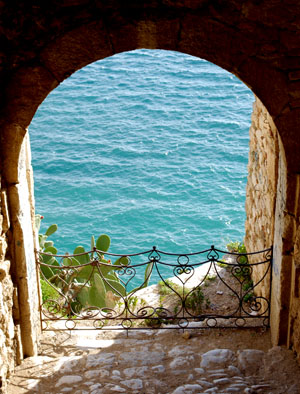 |
|
|
The demolition of the prisons began in 1970-71 in order to construct the 'Xenia Pallas' hotel, which involved the destruction of a large section of the walls and buildings of the Castello dei Greci. At the same time, Kapodistrias' military hospital was also demolished. The only thing that remains of the hospital is the chapel of Aghii Anargiri. |
||
|
Today, one can visit The Acronauplia climbing east from Staikopoulos Park through Arvanitias Square, or climb the steps from the Catholic church through the Castello di Toro. The exact location of the Acronauplia can be found in Section Map. It should be noted that the three enclosures of The Acronauplia can be seen best from the Palamidi. |
||


